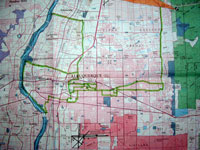A couple of months back, a friend loaned me a GPS gizmo, and I thought it was one sweet toy. I could slip it in the pocket of my bike shirt when I went riding, then plug it in when I got back and get a map of where I’d been, plus an elevation and speed profile.
Lissa and I went out walking around the neighborhood, tracing out a greeting to the world.
I coveted this toy. I love the concept of GPS art, and I imagined myself pocketing the little thing every time I rode, building up a rich map of my two-wheeled travels around the greater Albuquerque area.
And then I bought a map. (Click below to read more, this is kinda long for the aggregators.)
A couple of years ago, Malcolm Gladwell wrote a piece in the New Yorker that remains one of my favorite bits of writing, called The Social Life of Paper. It was a loving ode to what remains the finest technology for information storage and retrieval.
Computers offer extraordinary power. The ability to store vast amounts of data and quickly search through it is an important qualitative revolution. Google has quite literally changed my life. But when I need to get the information into my brain – when I need to usefully interact with it – there’s still no substitute for paper.
Last year, I dropped by the local REI to pick up a topographical map. I needed a quadrant up in the Jemez Mountains for a story I was working on, and I remembered their lovely big cabinet of topos. Turns out they don’t have it any more. Instead, it’s been replaced by an exciting new “maps on demand” computer technology. I perched at a screen, trying to navigate my way around mapspace to find the quadrant I needed. It was a hopeless task. The screen resolution wasn’t good enough, and there was no elbow room, that claustrophobic feeling you get when you’re peering through the soda straw of computerspace and have no feel for what lies outside the frame.
This wouldn’t have happened with the old paper maps. They had the big map on the wall, gridded up into quads, and you could move your eyes around it, run your finger over it, interact with it. If you thought you found the one you wanted, you could pull it out and look at it, hold it, move the information around in your three-dimensional cognitive world. A glance to the map’s right edge would show you which quad was next to it, and you could grab that one.
Gladwell tells the story of the strips of paper air traffic controllers use to identify each aircraft in the sky – how they position then on clipboards, move then around, literally passing the paper from one controller to the next as responsibility for the aircraft is handed off. To modern computer systems types, this seems hopelessly archaic. But it works, because the information is allowed to inhabit their three-dimensional space, out where they can get their hands on it:
Those strips moving in and out of the peripheral view of the controller serve as cognitive cues, which the controller uses to help keep the “picture” of his sector clear in his head. When taking over a control position, controllers touch and rearrange the strips in front of them. When they are given a new strip, they are forced mentally to register a new flight and the new traffic situation. By writing on the strips, they can off-load information, keeping their minds free to attend to other matters.
At work today, I was wrestling with a complex Nuclear Regulatory Commission case. The NRC keeps a voluminous electronic database of all documents filed in each one of its regulatory actions. The interface leaves something to be desired, but it’s functional and it’s all there, powerfully searchable. I was chasing footnotes from one document to the next, and the computer made them accessible. (Not easily accessible – if the NRC wants to contract with interaction design folks at Google to get some help, I’d be a happy guy. But at least they’re there.)
But once I found each one I wanted, I printed it out. I underlined the important bits in red pen, and put little sticky notes on the key pages, and stuck them all in a big sloppy messy file folder on my desk. Paper works.
So up on my wall, I’ve now got a 1 to 100,000 BLM topographical and land jurisdiction map of the greater Albuquerque area. And a green highlighter pen. I don’t need to boot up a computer to create the trace of my latest ride. I don’t need to boot up a computer to look at it.

